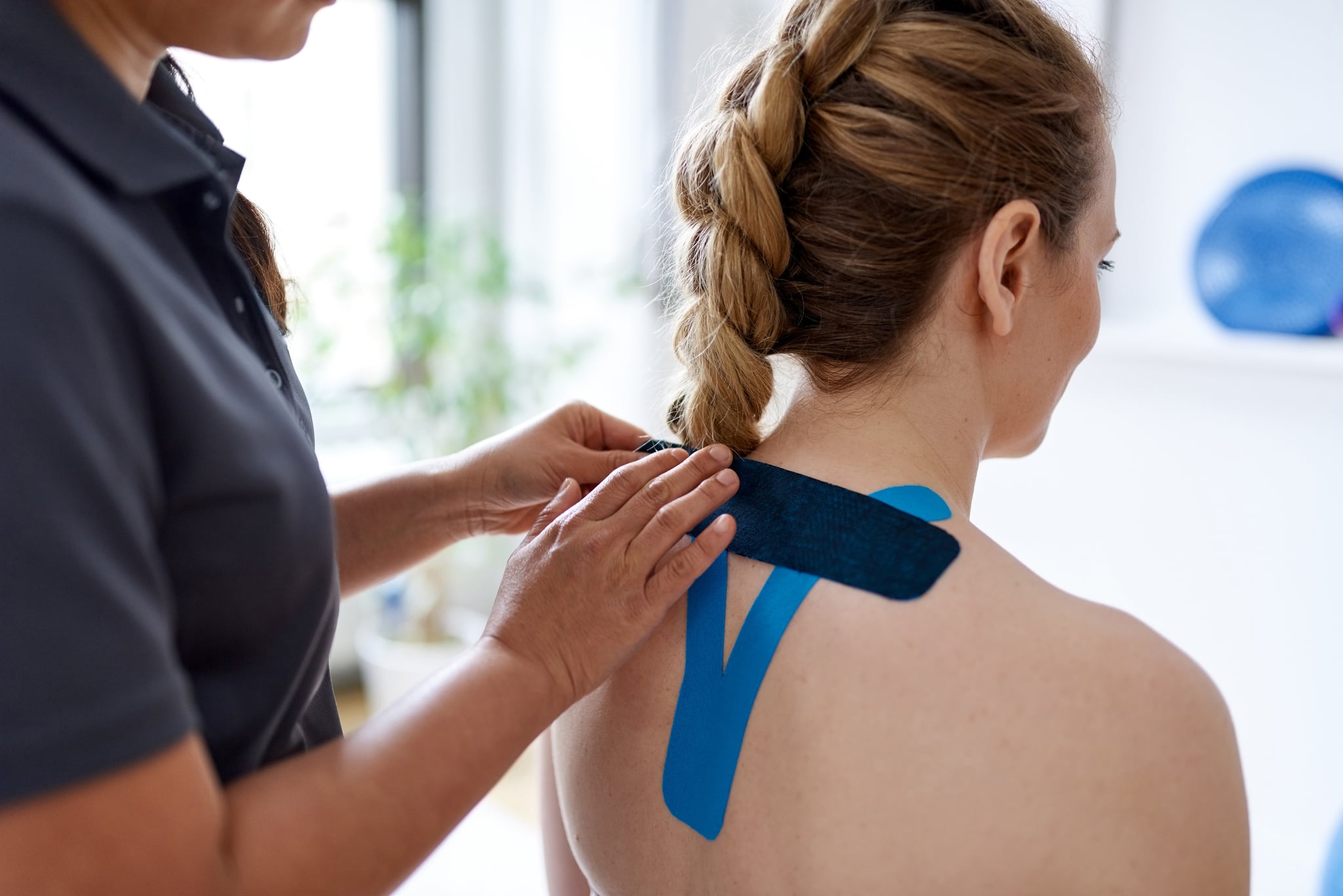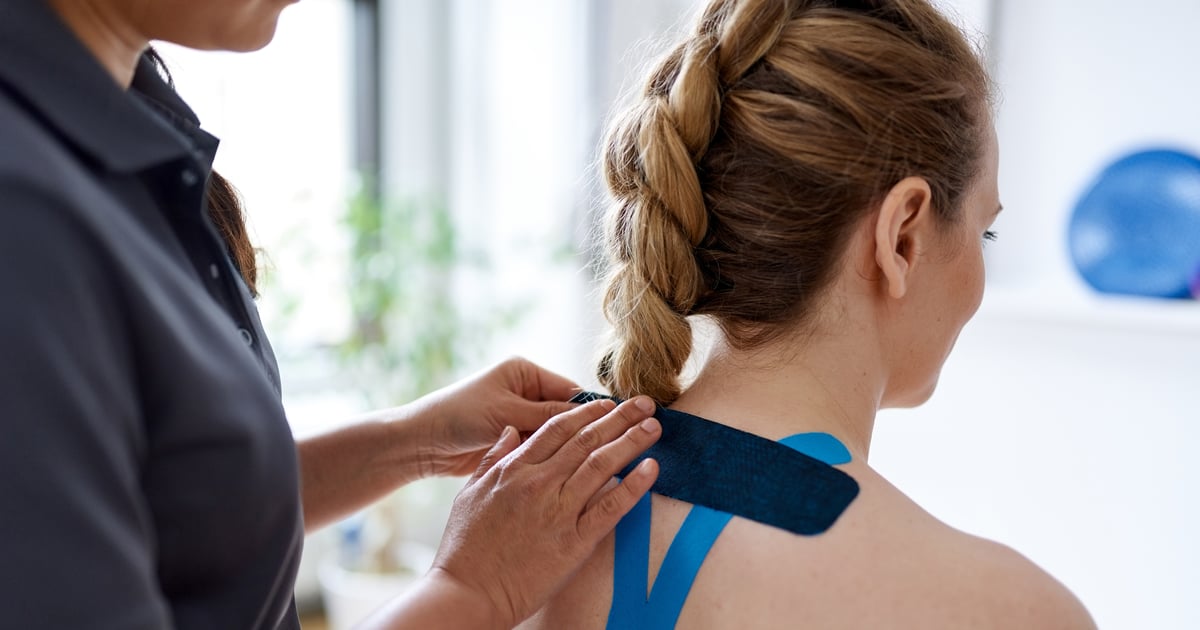
The equipment, uniforms, and skill set required to win may vary from sport to sport, but there seems to be one constant among elite athletes, regardless of modality: the use of kinesiology tape. The tape was beach volleyball player Kerri Walsh Jennings’ iconic shoulder accessory during the 2008 and 2016 Olympics. Serena Williams played the 2022 U.S. Open with small pieces of it on her cheek. And a handful of US Women’s National Team players are competing in the 2023 FIFA Women’s World Cup with it stuck to their thighs and knees.
But what is kinesiology tape, exactly, and how does it work? Here’s what to know, according to experts and research.
What Is Kinesiology Tape?
Created by chiropractor Kenso Kase, DC, in the 1970s, kinesiology tape is a cotton-based tape used for performance and rehabilitation purposes, according to the International Journal of Sports Physical Therapy (IJSPT). Unlike traditional athletic tape — which is rigid, provides stability, and prevents excessive movement — kinesiology tape is breathable, stretchy, and meant to improve circulation and muscle activation, says Rebecca Pudvah, DPT, CSCS, a physical therapist and board-certified orthopedic specialist at Athletico Physical Therapy.
Thanks to its breathable fabric, kinesiology tape allows sweat to evaporate and prevents heat from building up, so it’s less likely to peel off; you can often wear the tape for three to five days before needing to replace it, she notes. It’s also accessible to the everyday athlete, as it’s sold online, at pharmacies, and in sporting goods stores for less than $10 per roll.
The Benefits of Wearing Kinesiology Tape
In theory, wearing kinesiology tape on a specific muscle group or tendon could help enhance your athletic performance while you’re playing or working out as well as your recovery, Pudvah says. “One of the thoughts is that it lifts the skin up off the muscle to promote circulation of the lymph system to drain away the bad stuff [such as lactic acid] or get rid of swelling,” says Pudvah. “There are other thoughts that if you tape someone, it will increase muscle activation, though I haven’t seen a lot of successful research on that.”
Kinesiology tape may also help manage pain, which is why 67 percent of healthcare professionals use the tool, according to a 2021 survey of more than 1,000 athletic trainers, sports physical therapists, and orthopedic physical therapists. The idea is that the tape stimulates your skin’s mechanoreceptors (sensory receptors that respond to touch), per the study.
“Your body can only receive one stimulus from one area, whether that’s a pain stimulus or a sensory stimulus,” Pudvah explains. “A pain stimulus [travels to your brain] really slowly, so a light touch or pressure is going to get to your brain faster, so then you wouldn’t feel pain.” It’s the same reason why rubbing your shin after running into your coffee table seems to make the sharp pain go away, she notes.
Kinesiology Tape’s Limitations
Although some athletes and health pros swear by kinesiology tape, the studies conducted so far haven’t supported its perks. For example, following a systematic review of 15 studies, researchers determined that there wasn’t enough compelling evidence to support using kinesiology tape to improve sports performance. Likewise, a 2015 review of 17 studies found that using kinesiology tape provides better chronic musculoskeletal pain relief than minimal intervention, but it may not be any better than other treatment approaches.
“The evidence for kinesiology tape is extremely scarce, and one would be hard-pressed to find any significant, well-conducted studies claiming that it has any important effects, either from a rehabilitative or athletic performance standpoint,” adds Clinton Lee, PT, DPT, CSCS, a physical therapist and the founder and owner of PhysioStrength in New York City. In fact, a 2014 review published in the Journal of Physiotherapy found that kinesiology taping was no more effective in treating musculoskeletal conditions than placebo or other comparison groups.
Even if the tool has some pain-relief qualities, it’s not a cure-all. That’s why Pudvah recommends seeking out a physical therapist or athletic trainer for treatment. “I really want the individual to feel confident in what is wrong with them — to make sure that we’re taping it for the right reasons — because the tape is not going to magically make your pain go away.” Compounding the problem is a lack of evidence-based application practices, so the methods used — and, in turn, results — may vary from person to person, according to the IJSPT article.
So, Does Kinesiology Tape Work?
Given the lack of evidence supporting kinesiology tape’s benefits, Lee doesn’t recommend it to patients as a first resort. Instead, he suggests getting back to basics: Make sure you’re getting enough rest between athletic events, following a well-planned strength and conditioning program to build up your workouts appropriately, and staying on top of your nutrition. And if you’re injured, it’s best to see a health professional like a doctor or physical therapist versus taking treatment into your own hands. “These aren’t fancy recommendations, but they’re the most effective ways to reduce the risk of injury and to help with athletic performance,” he explains.
Still, there aren’t any serious risks that come with applying kinesiology tape — save for some potential skin irritation, says Pudvah. And considering it’s also relatively affordable and accessible, the tape can be worth utilizing if you personally notice an improvement in your performance and pain from using it, she adds.
“Is it much different than giving a child an emotional support sticker, otherwise known as a Band-Aid?” Pudvah says. “Not really, because it’s not going to make them worse . . . As long as you make it a part of the treatment and not the whole treatment, why not?”
Image Source: Getty / julief514
